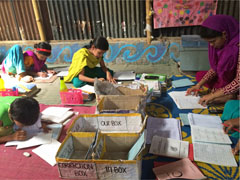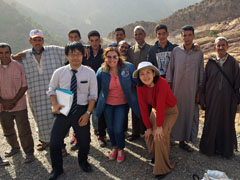InterviewJICA-RI Focus Vol. 41 - Interview with Research Fellow Mai Seki
2017.09.25
The JICA Research Institute (JICA-RI) is conducting research on the possible contributions of evaluating the impact of infrastructure on the keyword "inclusiveness." This is aimed at enhancing "quality growth," one of the priority issues emphasized in the Development Cooperation Charter. Research Fellow Mai Seki is involved in this analysis, utilizing her expertise in empirical micro research to conduct studies in the fields of education and labor, and to examine the development impact of infrastructure from a variety of perspectives, such as region and gender. We asked her about her activities.

■ Profile
PhD in Economics. She worked as a senior analyst for the Bank of Canada, and has been in her current position since June 2015. Research areas include applied micro econometrics, labor economics and economics of education.
- What led you to choose economics as your specialty?
My father was assigned to work in Zambia as a Japanese Overseas Cooperation Volunteer, so trainees from overseas were sometimes invited to our home. In retrospect, I realize that I have felt comfortable with foreigners from different cultural backgrounds since childhood. I became interested in the problem of poverty in my high school days. When I heard the news that Amartya Sen had won the Nobel Prize in Economic Sciences, I thought economics would be interesting as a field of specialty. That was the start of it.
When I was considering a major in college, there were a variety of areas from which to approach the problem of poverty, such as international relations and legal perspectives, but I decided to approach it from economics. I underwent practical training in policy analysis, incorporating both microeconomic and macroeconomic approaches at the public policy school. In my doctoral program, I ultimately chose labor economics and economics of education because they were familiar to me, and I believed they were important in the context of policy. I also participated as a research assistant in a project researching poverty among children in the United States, and turned my attention to the fact that poverty was a problem not only in developing countries, but in the developed world as well.
In my previous job at the Bank of Canada, I was in a department that handled monetary policy, and worked on analysis of the impact of population aging on the potential growth rate through labor input and productivity. In the process of recovery from the 2009 financial crisis, new issues garnered attention, such as workers discouraged due to long-term unemployment, skill mismatch among young workers and income inequality, so I learned the macro perspective of observing the labor market. Wanting to utilize my expertise in empirical micro research, I joined the JICA Research Institute in 2015. Until then, I had rarely worked with data on developing countries, but I believed policy issues could be found anywhere regardless of the differences between developed countries and developing countries, and that they could learn mutually from each other.
- Please tell us about these two areas of research you have worked on.
Education plays a vital role in economic growth and reduction of poverty, so I continue to be interested in it. My current research on education involves analysis of the effectiveness of the Kumon method of learning that was implemented in primary schools operated by the NGO Bangladesh Rural Advancement Committee (BRAC), in cooperation with Kumon Institute of Education Co., Ltd. since autumn 2014. It is also JICA’s initiative to encourage Base-Of-the-Pyramid (BOP) business cooperation to verify what contributions can be made by the Kumon method in improving the quality of education. We utilized indicators of not only cognitive abilities, such as academic abilities, but also non-cognitive abilities, such as self-esteem, which is where my interest also lies. I mainly handle writing of papers based on quantitative analysis. We visited BRAC primary schools and observed the teachers and students there, as well as their living environment. The Kumon method of learning has been implemented successfully in many countries around the world, and we found it effective at these schools as well.

Children are studying under the Kumon Method at a BRAC primary school
In addition, from the perspective of JICA, a business model is under consideration in which Kumon would support not only high-income earners, but also students in poverty who attend BRAC primary schools in developing countries. If this scheme is solidly established, it is likely that it will provide a model of market entry for Japanese companies into the markets of developing countries. In order for education to rectify the gap, it is important to determine the income group for which to deliver extra educational support. The mission of JICA and donors is to ensure that groups least likely to receive education are not left behind. Part of the analysis for this research has been completed, and a working paper was published in October 2017. We plan to write the second in the future.
Another area I am very interested in is the labor market. The research I am currently conducting is "Analysis of Youth Unemployment, Skill Mismatch, and Degree Inflation in Egypt." Some developing countries are facing a problem in the labor market, with people who graduate from a university or other institutions of higher education unable to find a job matching their education. In Egypt in particular, unemployment among young people with higher education is a significant societal problem. The same problem exists in the developed world as well, and how to deal with it is an important policy issue. We already have data on Egypt that we can use, so we would like to use a labor economics model to conduct a structural estimation.
To resolve the issue of worsening quality of education due to mass production at universities in Egypt and other factors, JICA supports the development of human resources in science and engineering and improvement of the quality of education by conducting the Egypt-Japan University for Science and Technology "E-Just” project and dispatching faculty members from Japanese universities. I began preparing for this research project in April 2016, and we are currently analyzing data. I hope to link the results of data analysis to JICA projects. At this stage, I believe it may be possible to find a connection between the labor market and higher education policy. There are many things that must be seen first-hand, so I am considering fieldwork in Egypt.
- What is your current focus of research concerning impact analysis of infrastructure?
How should we measure the impact of infrastructure development? There are a variety of ways to analyze the impact. However, with the establishment of the Sustainable Development Goals (SDGs), measuring the impact by incorporating inclusiveness in terms of gender, socio-economic background, and disabilities, is an approach that JICA can take with an institutional comparative advantage. I think evidence-based policymaking is critical to make maximal use of a limited ODA budget for optimal benefit and to ensure accountability to taxpayers.
In March 2016, a compilation of past research on the impact analysis of infrastructure was also released as a development cooperation literature review. Currently, I am analyzing how construction of rural roads in Morocco and the Delhi Metro subway system in India, supported by JICA, will impact education and women’s safe access to an infrastructure.
First, although Morocco is an extremely beautiful country, there is a significant gap in education and healthcare between urban and rural areas. The female teacher at the village primary school in the region where we conducted our fieldwork was unaccompanied by her family. It is a very remote area, and roads have not been maintained, so access is poor and she is only able to return home once each year. Even in such an environment, she was motivated as a teacher, but when we spoke with the Ministry of Education we found that, unfortunately, not all teachers are so. Recently, it has been proposed that, rather than having teachers sent to the villages, children should be sent from the village to live in a dormitory in town in order to make school attendance possible.

JICA-RI researcher Mai Seki, third from the left in the front row, conducted her fieldwork for JICA's Rural Road Improvement Project in Morocco
If the current gravel roads are paved with asphalt, it would be easier to travel, so we hope to conduct a quantitative evaluation of how it impacts education. This time, we are conducting an end-line investigation after roads are upgraded, based on a survey conducted in the baseline investigation, in cooperation with the JICA Evaluation Department, but it is difficult to manage the quality of the data. We have local consultants gather data, but the required level is high, and there are issues with translation, so it was a struggle to tough it out through repeated discussions. In the future, we will conduct additional analysis by putting satellite data and governmental data in a map.
As for the Delhi Metro in India, a major project for JICA as well, my research theme is how improved access to safe infrastructure will impact the lives of women. Delhi is viewed as a city difficult for women to safely live in. Speaking with the Delhi Transport Authority, UN Women and local women, we found that construction of the subway system had made it safer for women to travel, but that it was still dangerous to travel from home to the Metro station. The question is how to connect this last mile. We are formulating a research plan to analyze whether women will use public transportation more frequently, giving them more options for schools and making it easier to work outside the home if safety is ensured.
Evaluation of the impact of infrastructure is a completely new theme for me, so finding that I can apply the methods of empirical micro research, my specialty, gave me confidence as well. Being part of the JICA Research Institute has given me access to a professional network that allows me to immediately get the latest relevant information from practitioners and researchers within JICA and in international development organizations, which has been extremely helpful in research in this area. I believe the epitome of research is to combine a macro perspective that takes a long-term, overall view with a micro perspective that examines the development effect for individual attributes such as region and gender, and thereby make a balanced analysis.
You may have an impression that economic analysis is too academic to understand, but it is a misperception. Recent research tools of applied micro econometrics are easy-to-use and versatile. I hope I can serve as a bridge between such front-line economics and policies.

事業事前評価表(地球規模課題対応国際科学技術協力(SATREPS)).国際協力機構 地球環境部 . 防災第一チーム. 1.案件名.国 名: フィリピン共和国.

事業事前評価表(地球規模課題対応国際科学技術協力(SATREPS)).国際協力機構 地球環境部 . 防災第一チーム. 1.案件名.国 名: フィリピン共和国.

事業事前評価表(地球規模課題対応国際科学技術協力(SATREPS)).国際協力機構 地球環境部 . 防災第一チーム. 1.案件名.国 名: フィリピン共和国.

事業事前評価表(地球規模課題対応国際科学技術協力(SATREPS)).国際協力機構 地球環境部 . 防災第一チーム. 1.案件名.国 名: フィリピン共和国.

事業事前評価表(地球規模課題対応国際科学技術協力(SATREPS)).国際協力機構 地球環境部 . 防災第一チーム. 1.案件名.国 名: フィリピン共和国.
scroll